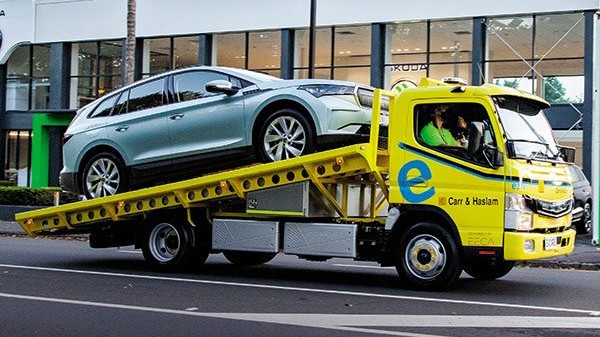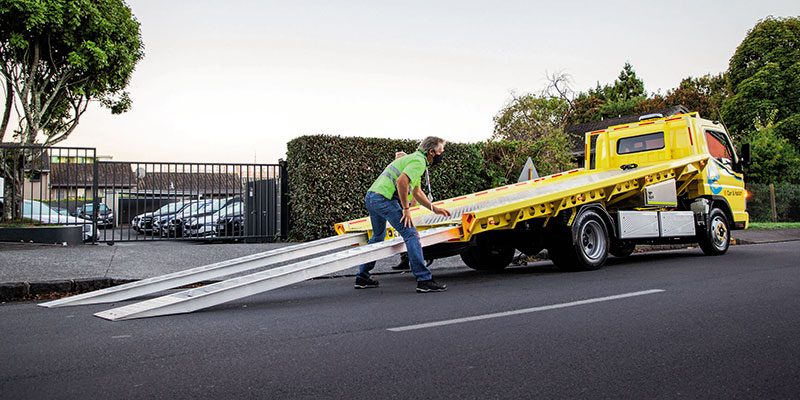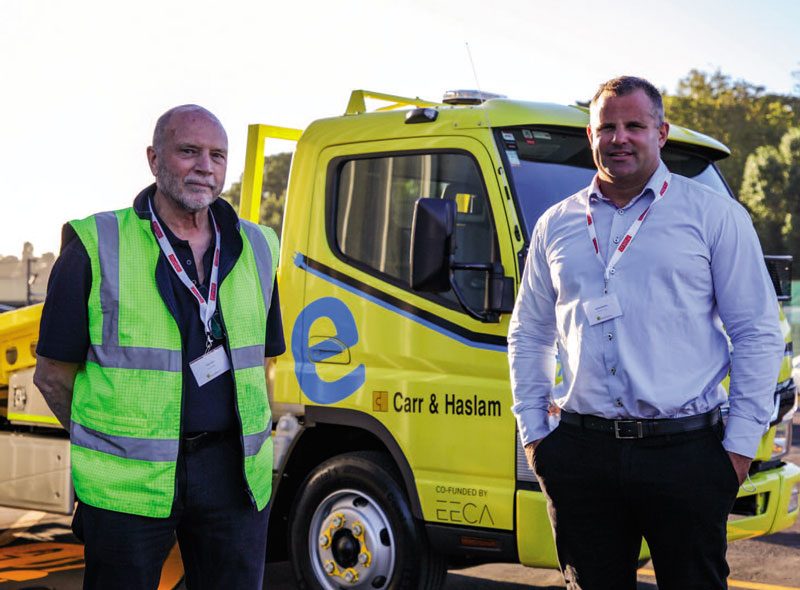
Creating change isn’t easy, especially when the tried-and-tested ways work. But, sometimes, you have to do it, and the only way is to start. That’s Carr & Haslam’s approach with its first electric transporter and, in doing so, the company is getting a head start on tomorrow.
Chris Carr, CEO of Carr & Haslam, is under no illusions that EV trucks are limited in their application capacity – in their current iteration. But to line up the company’s new eCanter and compare it directly with one of the five existing diesel- powered Canter transporters currently in the company’s fleet… Well, that would be missing the point.
The eCanter, which will operate exclusively within the Auckland area, enters the Carr & Haslam fleet as a stepping stone to the future. It’s a means by which the company will start paving its way into meeting future zero- emission mandates set not only by government but also by corporate customers with an eye on sustainability and eco-friendliness throughout the value chain.
Looking a century back in time, Chris draws parallels to his grandfather’s introduction of internal combustion – by way of a petrol-powered Brockway – to a fleet made up of horse and carts.

“We were one of the first companies in New Zealand to buy Euro-6 vehicles, and today we only buy from Euro-6 suppliers. There have been no incentives, just moral obligation. We knew at some stage that we’d have to add EVs to the fleet, so we figured, why not start off early? Now’s a good time to learn. It’s a big jump for us and it’s a big expense, but at some point, we’d have to do it.”
How much of an expense? Bluntly, about 2.5-times the price of a conventional Canter. But thanks to support from the Energy and Efficiency Conservation Authority (EECA) and its Low Emission Vehicles Contestable Fund, getting the eCanter into the fleet was made a bit more manageable. As with all eCanters currently in service, this one has been taken on a lease though TR Group for the next six years.

Right now, though, operating the eCanter will require a change of approach. Driver Dylan Gerrin is the man currently tasked with keeping tabs on proceedings. The eCanter has a dedicated parking spot and charger at the Carr & Haslam Mount Wellington depot, and the idea is that whenever it comes in to off-load or reload, it gets parked and connected for a fast charge top-up. On a 50kW fast charger, Fuso quotes a 100% charge in 80 minutes or an 80% top-up in 45 minutes. For interest’s sake, plugging into a 32A wall socket at 7.2kW will require a nine-hour park-up to reach 100%.
Fuso quotes 100-150km of range, depending on usage, of course, with two-stage regenerative braking doing its bit to prolong proceedings in town.

On the day of the eCanter’s launch into the Car & Haslam fleet, a demo run was lined up for us to see the eCanter in action – the first ‘EV on an EV’ delivery in New Zealand. A new Audi e-tron GT was loaded up, destination Giltrap Audi on Great North Road, New Lynn, before a Skoda Enyaq was collected from Giltrap Skoda on Great South Road, Newmarket, to be taken back to the Carr & Haslam yard.
According to driver Dylan, this little 36km round trip consumed less than 30km of range, indicating that maximising the eCanter’s 81kW/h battery should be easy enough with some predictive driving and basic route planning. Although it’s early days, Dylan says the eCanter typically displays 100km of range on a full charge, and he’s been able to get up to 140km out of it.
With a GVW of 7490kg and tare of 4260kg, payload is quoted as 3230kg. We know from prior experience with the eCanter that the electric motor’s 135kW, 390Nm output is perfectly ample, and hauling a 2.5-tonne EV will be no problem.

While the Enyaq is an electric SUV with a reasonable ground clearance, the low-slung e-tron is certainly the type of car that requires that extra bit of care when being driven onto or off from the transporter. For this reason, the fixed- angle deck was an important consideration and classily executed by Wiri-based Kingsford Motor Bodies.
“We cart a lot of high- end vehicles that are quite low, and EVs have the same characteristics. We can’t afford to damage the underneath of them. There are no angles where the car can bottom out on or off the truck. The only angle is where the ramps meet the road,” says Chris. Certainly, neither car had any issue with that. A winch is fitted but is expected to see minimal use.
Carr & Haslam expects the eCanter will cover roughly 20,000km a year throughout Auckland and expects to see gains brought about by a less demanding maintenance schedule, RUC exemption and a lower ‘fuel’ bill.

“Electric trucks are very different to electric cars – they’re a hard-sell. People don’t want them yet because of the limited range, limited gains in productivity, their weight and the fact they’re currently exceedingly expensive.
“They will get cheaper in time, and by then we’ll have learnt the different dispatching techniques, the different handling techniques, the things they can do and can’t do… We know the next iteration of this vehicle will be very different; we know the motor and batteries will be different. The technology will be way more advanced,” says Chris.
By that time, with the lessons learned from running this eCanter, Carr & Haslam should be well geared to continue its approach of ‘always buying the appropriate vehicle with the lowest possible emissions’, in an epoch where running EVs is increasingly seen as the norm.
Chris sums up: “We’re putting our money where government’s mouth is.”





